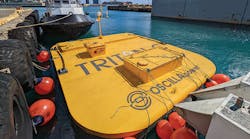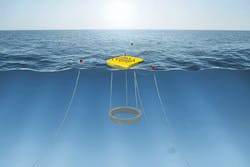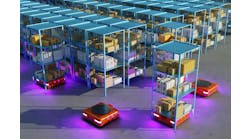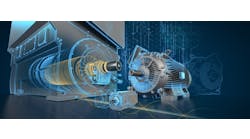The natural world produces vast amounts of power, but as usual, the trick is capturing and converting it for people to use. This used to mean extracting and burning hydrocarbons, but even though human civilizations are moving to alternative energy sources, this underlying challenge remains the same. Wind and solar, and even nuclear and geothermal, must each be tamed, controlled, managed in their own ways, and made accessible to overall grids and consumers. Even an emerging source like wave energy conversion (WEC) is no exception to this rule.
For instance, many players have tried to generate electricity from offshore waves in much the same way that today's wind farms produce power from prevailing winds. However, increasingly sophisticated process controls are needed to make these sources as efficient and consistent as their fossil forebears.
One of the most promising of these proposed solutions is by Oscilla Power in Seattle. It's developed a WEC system with six degrees of freedom, which can harvest energy by using the relative displacement between a floating vessel on the surface and a submerged, stable, inertial ring. These two parts are connected by three tendons that rotate internal drums as the vessel moves up and down on the waves, turning generators to produce electricity that can be delivered onshore. While similar devices only have two degrees of freedom and only move vertically, this new 33 x 25 foot (10 x 7 meter), 100-kilowatt (kW) Triton-C prototype from Oscilla can move in X, Y and Z planes, and capture energy from pitch, roll, yaw, heave, sway and surge (Figure 1).
Triton-C was launched in Honolulu harbor last October, and is currently completing final integration. It's expected to be installed soon at its offshore site in nearby Kaneohe Bay for a yearlong trial. Experimenting with the prototype is expected to give Oscilla the data and experience it needs to build a larger, 1-megawatt (MW) version of Triton that can deliver utility-scale power.
Finding the rhythm
Oscilla was inspired to pursue Triton because more than 70% of the Earth's surface is covered by water, and waves are a potentially enormous source of renewable energy. It cites estimates by the U.S. Energy Information Administration that the theoretical annual energy potential of waves off the U.S. coasts is as much as 2.64 trillion kWh, which is the equivalent of about 64% the electricity generated by the United States in 2019.
"The architecture we're following is the well-known, two-body point absorber, which has the advantage of surviving better in storms because it's more independent of water depth. However, we're adapting this concept by using three tendons to connect the two bodies, which makes Triton a multi-mode absorber," says Tim Mundon, CTO at Oscilla. "We've shown this concept to be highly efficient at extracting energy, and we've incorporated a survival strategy that allows Triton to submerge and be protected in the case of large storms.”
Ocean current to electric current
To maintain six degrees of freedom and operate as a multi-mode WEC, Triton's three tendons are mechanically connected to the vessel floating on the surface, where they're wrapped around three drums that turn as the vessel moves in relation to the ring below. However, this arrangement isn't enough to produce electricity, so each winch is also connected to a hydraulic system with gas bottles, which applies a constant torque to each winch and cable. This constant torque supports the ring hanging below, so that as the waves move the vessel, it causes a changing torque on the drum and drives three permanent-magnet generators to produce power. The generators are controlled by velocity, while the hydraulic system is also tunable, and the system can autonomously change parameters to those that provide the best performance in different conditions (Figure 2).
Figure 2: Triton-C harvests energy by using the relative displacement between a floating vessel on the surface and a submerged, stable, inertial ring. These two parts are connected by three tendons that wrap around drums and drive three generators. Generators and drive controllers are managed by an on-vessel Simatic s7 PLC with an IPC and customized optimization algorithms. Power is conditioned with supercapacitors, inverters and onboard battery. All these parts combine to provide up to 100 kW of regular, steady-state 720 VDC to shore. Source: Oscilla Power
Not surprisingly, Triton's drums, hydraulics, generators and power electronics require some sophisticated coordination and management for motion control, motion-to-grid conversion and supervisory control. Oscilla began working several years ago with Applied Control Engineering, a system integrator in Newark, Del., on defining the control system requirements for its base architecture. ACE developed the control and configuration design for Triton, as well as its high-availability, secure communications network.
"Triton is controlled by a PLC system from ACE, which includes a central, on-vessel PLC in a central cabinet and three remote, satellite cabinets, one for each drivetrain. The PLC is updated on a sub-second basis to make sure the right amount of torque is applied to each of the three generators and their cables," explains Mundon. "This system uses fast lookup tables and fast communications for specifying values and applying them quickly. Triton wouldn't be able to function without these controls."
For its Triton-C prototype, ACE implemented a Simatic PLC with Totally Integrated Automation (TIA) and WinCC RunTime Professional front-end software from Siemens. This control platform also includes hardwired communications with a cellular backup. A single Simatic industrial PC (IPC) collects data every 20 milliseconds, gathers historical information, performs local visualization, and mirrors its data onshore for backup purposes and easier access.
Controlling the generators
To further manage each of the three generators and the power coming from them, Oscilla also worked with Siemens Digital Industries (SDI) and the company's OEM division, and with system integrator Applied Motion Systems (AMS) in Vancouver, Wa., which is also a Siemens solution partner.
"These generators can produce large peak currents during energetic sea states, and these peaks are interspersed with periods of inactivity when no energy is produced. Peaks are captured in a super-capacitor bank combined with lithium-ion battery storage. The batteries operate at 310 VDC for local power needs and smoothing of export power" says Ken Brown, founder and CEO of AMS. “Power is exported to shore at a steady-state 720 VDC. This will let the Triton-C prototype deliver a maximum of 100 kW continuous to the grid onshore, while the full-sized Triton being developed will deliver about 1 MW to shore."
Brown reports that Siemens inverters manage power from the generators by way of a Sinamics CU320-2 drive controller. This controller manages inverter commutation algorithms, current (torque) limits and generator velocities for maximum energy production for any given sea state. A second controller manages WEC auxiliary loads and vessel monitoring tasks. These controllers also interface with the vessel's SCADA system developed by ACE where they report vessel and power system status.
"The super-capacitor bank stores a huge amount of energy, so it's important to make it and Triton safe during maintenance operations by discharging this energy in a controlled fashion. This is managed using large resistors and fans to dissipate energy when needed." explains Brown. "Meanwhile, the batteries are maintained at 310 VDC for black start capability through the DC/DC converter system. In addition, the physical mountings for these components are designed for an energetic, marine environment, where they'll obviously be tossed around a lot."
Brown adds that AMS has done some energy-recovery projects before, and this experience helped its work on Triton. "For instance, Lucid Energy added turbines to municipal water pipes in Portland, where the reservoir is much higher than the city," says Brown. "Because pipe pressure increases with decreasing altitude, this system has been deployed in place of pressure-reducing valves, and has been producing energy for several years, while lowering water pressure to acceptable levels. We've been able to reuse some of the generator control code from that project for the Triton-C generators. Another useful benefit of using Siemens devices includes a well-integrated DC/DC converter that allows us to deal with a wide range of DC voltages from Triton, while maintaining that nice, steady 720 VDC to shore.
"The engineering challenge with these projects has been creating custom algorithms that can control voltage and current simultaneously. Our team developed software algorithms to optimize voltage and current for energy production using software created in the starter program that runs in the CU320. Also, using this software and hardware combination allowed a seamless connection between the SCADA system and the generator and battery energy management system."
Accessories, HMI and analytics
Similarly, ACE reports that TIA Portal also integrates between the PLC and a Siemens motor control center (MCC), which lets users configure Triton's motors, HMI and PLC in the same platform. Beyond these control and monitoring functions, ACE also set up interfaces for TIA Portal to communicate with external systems, including:
- Speedgoat real-time hardware simulation machine via Modbus protocol;
- GPS system to make sure the float is correctly positioned, also via Modbus;
- Monitoring system to check the health of the primary capacitor bank via CANbus protocol; and
- Win911 alert and alarm system via wireless/cellular network, which provides real-time text and email notifications when abnormal conditions are detected on the unmanned vessel.
ACE adds that Speedgoat performs advanced calculations to determine the ideal torque for the generators that will maximize energy from incoming waves. The system integrator also wrote a custom Python software script, which collects a combination of data, such as web-based weather and satellite information, wave data from remote buoys and local measurements at the float, and pushes that data to the PLC, where Speedgoat can access it via Modbus protocol. Speedgoat uses all this data to calculate the most efficient torque for the generators, and passes that information back to the control system, which signals the MCC. This enables real-time adjustments to be made to Triton's parameters to maximize wave energy captured and power produced. Because of limited space on the vessel, its local IPC not only collects data and serves graphics for the local HMI, but it also runs the data-gathering Python script, and hosts a virtual machine from Canary Labs that's dedicated to the historian.
Finally, ACE developed custom PLC function blocks and HMI faceplates to meet Oscilla's needs. While the HMI runs locally on Triton, it's also accessible onshore. To make it easier for users monitoring these vessels, especially as they're expected to multiply in the future, ACE adhered to ISA-101 guidelines for situational awareness. It used grayscale graphics with color reserved for alerts, and developed an intuitive, single-click navigation, so operators can quickly identify and mitigate potential issues.







